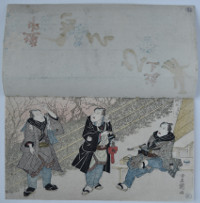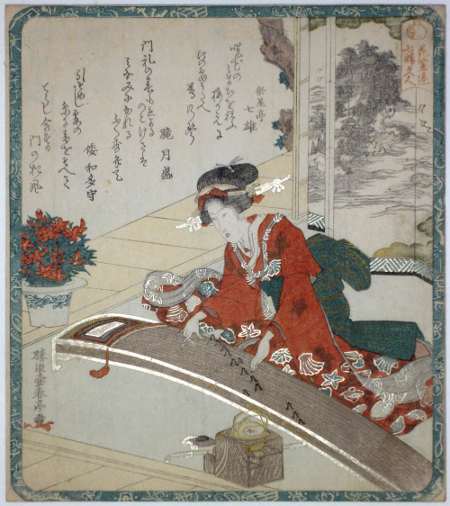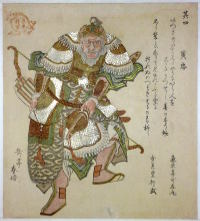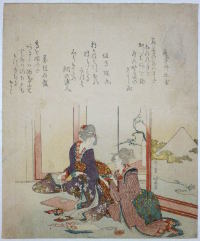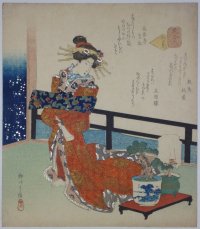/category/surimono/page/2/
Yashima GAKUTEI (1786?-1868)
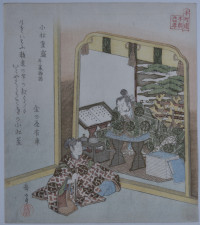
Click here to view image full size.
A surimono, Komatsu Shigemori, from the Heike Monogatari. One of a set with series title: Honchoren honcho nijushiko, “Twenty-four Japanese Paragons of Filial Piety for the Honcho Circle.” Issued by the Honchoren poetry club, c. 1821. Shows Taira no Kiyomori (1118-81) seated in an alcove being admonished by his son Shigemori (1138-79) for not being as loyal to the emperor as he had been. Kiyomori was a famous military leader and head of the Taira Clan. Poem by Kanenoya Arikado.
Fine impression, colour and condition with silver and gold. Signed Gakutei with Sadaoka seal.
Status: Sold
Utagawa TOYOKUNI II (1777-1835)
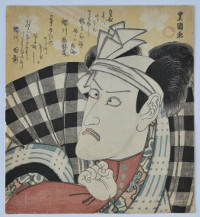
Click here to view image full size.
A surimono showing a bust portrait of the actor Ichikawa Danjuro VII as Kanawa no Goro, a retainer of Kamatari no Fujiwara, disguised as the fisherman Fukashichi from the Mikasayama Goten scene at the palace on Mount Mikasa in Act 4 of Imoseyama onna teikino. Three poems by Shoshokyo Otokado, Sakuragawa Jihinari and Sakuragawa Omokage. Issued c. mid 1820s. Rare.
Fine impression. Very good colour and condition. Signed Toyokuni ga.
Status: Sold
Yashima GAKUTEI (1786-1868)
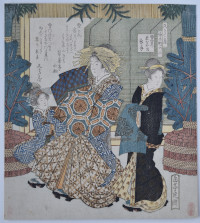
Click here to view image full size.
A surimono, Ni, Yukiwake no Wakanaya uchi Koromode, “Number Two: The Snow Clothes of Koromode of the Wakanaya” from the pentaptych entitled Hisakataya Nakanocho, “The Nakanocho for the Hisakataya Poetry Club.” Issued c. 1827. Shows the oiran Koromode of the Wakanaya parading with her Shinzo and another courtesan down the Nakanocho, the main street of the Yoshiwara. Two poems by Suihotei Komatsu and Hisakataya.
Fine impression, colour and condition with extensive gold and silver. Signed Gakutei Sadaoka.
Status: Sold
Katsushika TAITO II (Fl. c 1810-1850)

Click here to view image full size.
One of the great surimono designs and extremely rare: There appear to be four other genuine examples recorded, apart from this impression, which is from the Vever collection. (See Vever sale, Sothebys, 1977, lot 302. In fact, Vever had two copies. The other sold Vever sale, Sothebys, 1978, lot 231.) The Baur impression. See The Baur Collection, Matthi Forrer, Geneva, 1994, Volume 1, G224, and is also illustrated in the Chiba Museum catalogue, Ukiyo-e bino kiwami, 2001, no. 126. The Chester Beatty impression. See The Art of Surimono, Roger Keyes, Sothebys, 1985, vol. 2, no. 335, p. 384 (ex Gonse). And the MFA, Boston, impression, accession no. 11.20424, ex William Sturgis Bigelow. Three poems by Bunshuro Tomoyoshi, Bunkaro Kiyomaru, and Bumbunsha. Shows a carp swimming down amongst water-weeds and cherry blossom. The carp was a symbol of achievement against adversity in Japan and had a connotation with the new year. In fact, Taito designed another print of a carp amongst water-weeds which is part of a harimaze sheet and is most often encountered with the left calligraphy removed. Issued c 1832 for the Taikogawa Poetry Club. Vever seal bottom right.
Very fine impression with burnishing on the eye and the cherry blossom blind-printed. Fine colour. Minor foxing, otherwise very good condition. Signed Katsushika Taito.
Status: Sold
Totoya HOKKEI (1780-1850)

Click here to view image full size.
A surimono showing the poetess Kiyogaki standing on Mukaigaoka Hill overlooking a frozen Shinobazu Pond with the shrine of Benten. (And since the snake was the messenger of Benten, this print was probably issued for Snake Year 1833.) Two poems by Tojuen Kiyogaki and Yayoian.
Fine impression and colour with extensive silver – especially on the frozen lake. Slight soil, otherwise very good condition. Signed Hokkei.
Status: Sold
Totoya HOKKEI (1780-1850)

Click here to view image full size.
A surimono from a set Onkyoku zukushi, “An Array of Songs.” In the cartouche, top right, on the right, is Tokiwazu (a school of vocal music featuring the 3-stringed shamisen), and on the left the title of the musical piece illustrated here, which is Oimatsu, “Old Pine Tree,” a brief and auspicious piece composed in 1747 and used for celebratory occasions. A warrior is shown reclining against an old pine in heavy rain. Issued c 1818. Another from the set is illustrated in Reading Surimono, John Carpenter, Hotei publishing, 2008, no. 76, p. 203. Rare.
Fine impression with gold, blind-printing and the rain printed in silver. Very good colour. The red may be down slightly but, as yet, I have not found another impression to compare. Very good condition. Signed Hokkei.
Status: Sold
Yashima GAKUTEI (1786-1868)

Click here to view image full size.
A surimono showing Li Kui (Jap: Ri Ki), one of the brigands from the One Hundred and Eight Heroes of the Popular Water Margin (the Suikoden). He was nicknamed the “Black Whirlwind” and is usually shown wielding two giant axes (as here). From a set Suiko Juban, “Ten Characters from the Water Margin.” Probably for the Kadonumaren Poetry Club c. late 1820s. Another two designs from the set are in the Harvard Art Museums, 1933.4.2003 and the Asian Art Museum, S.F., 2010.193. Rare: I cannot locate another impression at the moment.
Fine impression and colour. Slight soil and possibly slightly trimmed, otherwise very good condition. Extensive silver. Signed Gakutei Harunobu.
Status: Sold
Utagawa KUNINAO (1793-1854)

Click here to view image full size.
A surimono with series title Bijin awase, “Beautiful Women.” Shows a scantily clad diver emerging from waves holding an abalone shell and clinging to a rock. There are obvious erotic overtones to this wonderful surimono: Awabi divers were objects of great voyeuristic curiosity to the general public and feature in many aspects of Japanese art. Poems by Chinchoya Chincho and Jingoro Takumi. Provenance: Ex collection Louis Gonse, 1846-1921, who was a great collector of Japanese art and published L’Art Japonaise in 1883. Seal au verso. Very Rare: Other impressions are in the Chester Beatty Library, Dublin. See The Art of Surimono, Roger Keyes, 1985, no. 236, p. 267; MFA, Boston, RES.46.27; and illustrated in McKee, Colored in the Year’s New Light: Japanese Surimono From The Becker Collection, Cornell University, 2008, no. 112.
Fine impression and colour with silver printing to the waves. Evidence of mounting around edge au verso, otherwise fine condition. Artist’s seal Kuninao.
Status: Sold
Utagawa KUNIYOSHI (1797-1861)

Click here to view image full size.
A surimono from a series: Fuzoku onna Suikoden hyakuhachiban no uchi, “Modern Women as the One Hundred and Eight Heroes of the Suikoden.” Shows a beauty leaning on a fulling block beside a stream. She gazes at a flowering cherry tree with a village in the distance beneath a full moon. Each design is based on one of the characters from the Suikoden; in this case Shinkigunshi Shubu (Zhu Wu), the “Resourceful Strategist.” The series was inspired by a new translation of the 12th century Chinese novel Shui huchuan, “All Men are Brothers” which relates the deeds of a group of outlaws. Commissioned by the Hisakatayaren Club for the New Dragon Year 1832. Surimono were usually issued by these poetry clubs or for specific occasions, although individuals also commissioned them. They could employ every artifice available to the printers and engravers: metal powders, mica, blind-printing and burnishing, and were printed on the best, thick hosho. They were not issued in large numbers as conventional Ukiyo-e and are usually of a smaller format. Presumably ambitiously planned as 108 prints but never completed. Rare.
Very fine impression and colour with silver and gold. Slightly trimmed top and bottom, otherwise very god condition. Signed Ichiyusai Kuniyoshi ga with the red seal of the printer Suriko Shinzo (which is removed on some impressions).
Status: Sold
Ryuryukyo SHINSAI (1764[?]-1823)

Click here to view image full size.
An early pupil of Hokusai who is best known for his fine surimono, but also produced a series of semi-western style landscapes and some paintings. A still life showing a group of pouches, one revealing a lacquered surface with a stylised dragon. Dragon year was 1808 and 1820. Extremely rare. Ex Beres collection, seal au verso.
Fine impression with extensive silver and burnishing. Fine colour. Very good condition. Signed Shinsai.
Status: Sold
Totoya HOKKEI (1780-1850)

Click here to view image full size.
A surimono showing an unidentified fish – possibly a flying fish and carnations. An apparently unrecorded surimono. A pupil of Hokusai, Hokkei’s oeuvre was almost entirely in this genre, apart from illustrating ehon.
Very good impression and colour. Slight crease, otherwise very good condition. Signed Hokkei.
Status: Sold
Totoya HOKKEI (1780-1850)
Click here to view image full size.
An uncut large surimono with the poems attached showing a rustic bridge in a country setting. Geese flying above. Published c 1810s. Provenance: Ex Samuel Tuke collection, seal centre left. Tuke was a member of the Japan Society of London and many of his prints went to the British Museum, while others were sold at Sothebys in 1911. Rare.
Very good impression, colour and condition. Signed Totoya Hokkei ga.
Status: Sold
Chokotei TOSHIMASA (Active c 1810s)
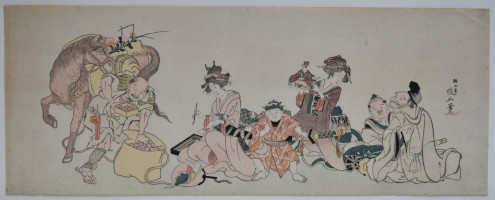
Click here to view image full size.
A long surimono for a Horse year (probably 1810). Shows the Five Festivals, Gosekku no uchi, which are: Matsu-no-uchi, New Year; Hinamatsuri, Girls’ Day, or Doll Festival; Tango-no-sekku, Boys’ Day; Tanabata, Star Festival; Choyo-no-sekku, Chrysanthemum Festival.
Very good impression, colour and condition. Signed Chokotei Toshimasa hitsu.
Status: Sold
Utagawa TOYOKUNI II (1777-1835)
Click here to view image full size.
A surimono showing a bust portrait of the actor Ichikawa Danjuro VII as Kanawa no Goro, a retainer of Kamatari no Fujiwara, disguised as the fisherman Fukashichi from the Mikasayama Goten scene in Act 4 of Imoseyama onna teikino. Three poems by Shoshokyo Otokado, Sakuragawa Jihinari, and Sakuragawa Omokage. Issued c mid-1820s. Provenance: originally purchased from me in 1977 (see my catalogue 20, 1977, no. 38). Unidentified collector’s seal au verso. Rare.
Very good impression, colour and condition. Signed Toyokuni ga.
Status: Sold
Utagawa TOYOKUNI I (1769-1825)
Click here to view image full size.
A surimono in the form of an ema (literally “picture-horse”) which were votive tablets left at Shinto shrines. The upper right plaque shows an actor in Shibaraku role with characters reading ganshu (temple petitioner) Bunri. Below, ten poems by poets from Edo, Kyoto and Osaka. The poem below the actor is signed Shikan which was the stage name and literary name of Nakamura Shikan I (Utaemon III, 1778-1838) who is most likely the actor portrayed. The text on the top left panel begins with San kudari indicating the 3rd came back, suggesting a return by Utaemon to Edo from acting in Kyoto or Osaka. Issued c 1810s. Very rare.
Very good impression, colour and condition. Signed Toyokuni ga.
Status: Sold
Utagawa TOYOKUNI I (1769-1825)
An extremely rare and unusual e-goyomi surimono for the year of the Horse, 1822, the long and short months running along the top of the theatre curtain. The surimono shows the Ichimura Theatre in Edo. The theatre curtain over the stage is a flap that hinges up to reveal the actors within. The characters on the curtain in pink and gold read: Shinjo hiiki renchu, “An offering from the [associated] patronage clubs.” (In fact, three fan clubs plus a daimyo, Mori Narimoto, whose poem top left is signed with his art name Ryuotei Edo No Hananari.) The three actors revealed are, from left to right, Seki Sanjuro II, Onoe Kikugoro V, and Ichikawa Danjuro VII in the play Three Famed Warriors Crossing Paths. However, they are not shown in character but dressed casually. Their emblems appear on the curtain: the waterfall-ascending carp for Danjuro; the chrysanthemum for Kikugoro; and the crosshatch for Sanjuro. Another impression is illustrated in The Private World Of Surimono, Sadako Ohki and Adam Haliburton, Yale University Press, 2020, no 59, p. 213. An impression missing the flap is illustrated in Surimono: Prints By Elbow, Edythe Polster and Alfred H. Marks, Lovejoy Press, 1980, F-D 1933-4-898, p. 441 and 437. Provenance: Ex H. Beres collection, sold Sothebys, Paris, 27/11/2002, lot 85. Seal on reverse.
Very good impression and colour with gold and silver. Very good condition. Signed Toyokuni ga.
Status: Sold
Totoya HOKKEI (1780-1850)

Click here to view image full size.
A surimono showing three overlapping fans. The top fan shows the first sunrise of the new year behind a shachi on a castle roof. Usually called dolphins, they in fact had the head of a tiger and body of a carp. The second shows a court lady and attendant collecting young pines on the first day of the year. The third shows an imperial ox cart. Possibly for the Ox year 1829. Another impression was in the Adolphe Stoclet sale, Sothebys 8th June 2004, lot 463, p. 242. Poems by Shinshukei, Shigekado and Shinratei Manzo (leader of the Manjiren club).
Very fine impression and colour with gold and silver. Fine condition. Signed Hokkei.
Status: Sold
Yashima GAKUTEI (1786-1868)
Click here to view image full size.
A surimono – one of a series that Gakutei designed in the curved shape of a folding fan. Shows a seated poet before Mt. Fuji holding a fan and dressed in courtly robes with a New Year pattern of pine trees and an eboshi cap. Two others from the set are illustrated in The Art of Surimono, Roger Keyes, Sothebys, 1985, pl. 47, p. 89; and Sammeln Magazin, Nr. 6, Juni 1985, p.15. Issued c. 1821. Provenance: Ex Toni Strauss Negbaur collection, seal au verso.
Fine impression with Mount Fuji blind-printed. Very good colour and condition. Signed Gakutei.
Status: Sold
Katsukawa SHUNTEI (1770-1820)

Click here to view image full size.
A surimono, number two, from a set of three entitled Buyu sanban tsuzuki, “Three Examples of Martial Bravery.” Shows Minamoto no Tametomo (1139-1170). A famed archer and of huge stature, he is shown here with his bow and arrows being offered a coral tree from a representative of a conquered land. Shuntei, a pupil of Katsukawa Shun’ei, produced a number of surimono as well as working in other genres. Issued for the Taikogawa Poetry Club, c late 1810s. Poems above by Wajotei Harunaga and Kasentei. The other two from the set are in the MFA Boston, 53.2733 (the first) and 53.2735 (the third). Another impression of this design is also in MFA Boston, 53.2734. Ex collection Louis Gonse, seal au verso. Rare.
Fine impression and colour with extensive gold and silver. Fine condition. Signed Shokyuko Shuntei ga.
Status: Sold
Utagawa SADAKAGE (Act. c 1818-1844)

Click here to view image full size.
A surimono showing a courtesan and her acolyte playing a Hyakunin Isshu version of uta-garuta, a card game where a hundred poets are matched to a hundred poems. Karasaki: Night rain on a festival day from a set of surimono Kuruwa hakkei, “Eight Views in the Licensed District [the Yoshiwara].” The Eight Views theme , which came from China, was embraced by ukiyo-e, firstly depicting landscape views but then extended to cover accomplishments or moments of the day, usually associated with fashionable beauties. The set issued by the Biwaren Poetry Club in 1832. Their stylised symbol – the biwa – appears in the border.
Very fine impression and colour with gold, silver and blind-printing. Very slight crease, otherwise fine condition. Signed Gokotei Sadakage. Rare.
Status: Sold
Yashima GAKUTEI (1786-1868)

Click here to view image full size.
A surimono with title Kiyomihara no Oji, “The Kiyomihara Prince” from a set based on the Uji Shui Monogatari, “Tales Gleaned from the Uji Councillor,” this being Minamoto no Takakuni (1004-77). This episode from chapter 15 relates how the succession to the Emperor Tenji, who had died, is disputed between Prince Oama (the former emperor’s younger brother) and Prince Otomo (the former emperor’s son by a low-ranking woman). Oama, fearing an attack, escapes. Coming to the Sunomata Crossing in Mino Province he is unable to cross the river. A local woman tells him all boats have been confiscated by Prince Otomo. To escape detection she agrees to hide him under a bucket. Evading arrest he asks her to recruit an army of local men, which she does and they go on to defeat Prince Otomo. The woman was said to be the god of Fuwa. Rare.
Fine impression. Very good colour and condition with silver, gold and blind-printing. Signed Gakutei.
Status: Sold
ANONYMOUS
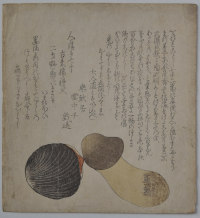
Click here to view image full size.
An unusual and rare surimono showing a matsutake, pine mushroom, and an akagai, red clam. Obvious sexual connotations due to their similarity to the human anatomy. The inscription is enigmatically signed Master In-The-Clouds or Humourously related by the Master who is relaxing and drinking while living in the clouds. With a reference to the Chinese immortal sage Yunzhongzi. Surimono were usually issued by poetry clubs or for specific occasions, although individuals also commissioned them. They could employ every artifice available to the printers and engravers: metal powders, mica, blind-printing and burnishing, and were printed on the best, thick hosho. They were not issued in large numbers as conventional Ukiyo-e and are usually of a smaller format.
Very good impression and colour. Slight soil, otherwise very good condition.
Status: Sold
Utagawa Toyokuni I (1769-1825)
Click here to view image full size.
A pupil of Toyoharu, he is best known for his fine actor prints at the end of the 18th century. He had many pupils. A koban surimono showing Ichikawa Danjuro VII in Shibaraku with the voluminous costume and chikara gami “strength papers” sticking up at the back of his wig. Issued for the New Year 1810 (confirmed by the characters hatsu-ushi [“the first year of the ox”] in the first line of the left-hand poem). Interestingly, Danjuro did perform Shibaraku in the play Misao no hana toba koizuka at the Ichimura-za theatre just a couple of months before (11th month, 1809). The role name being Kaneomaru.
Very good impression and colour. Minor toning, otherwise very good condition. Signed Toyokuni ga.
Status: Sold
Yanagawa SHIGENOBU II (active c 1820s-1850s)
Click here to view image full size.
Number one from a surimono series Hana-awase, “A Flower Competition.” Sub-title Takane no hana, “Flowers of the Peak.” A princess turns to her attendant. Published c early 1830s.
Fine impression with touches of gold and silver. Fine colour and condition. Signed Yanagawa Shigenobu.
Status: Sold
Honda UNRIN (Active c. late Edo period)
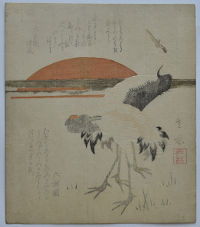
Click here to view image full size.
A surimono of a male and female red-crowned crane (aka Manchurian crane). Behind a huge setting sun. The crane represents good fortune, longevity and fidelity in Japan and is a popular subject for surimono. Unrin, a Nanga/Shijo artist, was a pupil of Tetsuo (1791-1871). Issued c. 1840s.
Fine impression with the birds outlines and plumage beautifully blind-printed. Very good colour. Minimal soil, otherwise very good condition. Signed and sealed Unrin.
Status: Sold
Katsukawa SHUNTEI (1770-1820)
Click here to view image full size.
A woman playing a koto from the set: Hanagasa-ren Shichifukujin, “Seven Women as the Gods of Good Luck for the Hanagasa Club. Each beauty represents a god, presumably in this case Benten. The series may be a parody of the new year tradition of making a pilgrimage to the seven shrines devoted to each of the Seven Gods of Good Luck. The set of eight prints published c 1820.
Fine impression and colour with silver and gold. Light backing, otherwise very good condition. Signed Shokyuko Shuntei ga.
Status: Sold
Yashima GAKUTEI ( 1786-1864 )
Click here to view image full size.
A surimono showing the Chinese warrior Huang Zhong ( Jap: Ko Chu, d. 220 AD ). Best known for his role in the novel Tale of the Three Kingdoms. He is shown wearing tiger skin breeches and armed with a large sword, bow and arrows. From a set Go koshogun, “The Five Tiger Generals.” Title on right Sono yon Ko Chu, “Nr 4 Huang Zhong. “ Issued by the Asakusagawa Poetry Club ( seal top left ) for the Tiger year 1818. Two poems by Shinsokutei Kashimaru ( right ) and Hogetsudo Yukitake ( left ).
Fine impression. Very good colour with extensive gold and silver. Very good condition. Signed Gakutei Harunobu.
Status: Sold
Yashima GAKUTEI ( 1786-1864 )
Click here to view image full size.
A surimono showing the Chinese warrior Ma Chao ( Jap: Ba Cho, 176-222 AD ). Best known for his role in the novel Tale of the Three Kingdoms. He is shown leaning on a giant axe. From a set Go koshogun, “The Five Tiger Generals.” Title on right Sono go Ba Cho, “Nr 5 Ma Chao. “ Issued by the Asakusagawa Poetry Club ( seal top left ) for the Tiger year 1818. Two poems by Ki no Yoshito ( right ) and Sengetsudo ( left ).
Fine impression. Very good colour with extensive gold and silver. Very good condition. Signed Gakutei Harunobu.
Status: Sold
Katsushika HOKUSAI ( 1760-1849 )
Click here to view image full size.
A surimono showing two young girls making new year envelopes. On the side screen is a view of Fuji. Three poems above. Published c 1806.
Fine impression and colour. Small strengthened area au verso, otherwise very good condition. Signed Hokusai ga.
Status: Sold
Yashima GAKUTEI ( 1780-c 1869 )
Click here to view image full size.
A surimono showing the nine-tailed fox ( Tamamo-no-mae ) and the warrior Miuranosuke who was a palace guard in the court of Emperor Konoe ( 1139-1155 ). Issued c 1826 for a sub-group of the Biwa-ren poetry circle ( emblem top right ) headed by Benbenkan. Poems by Bentandai Gihoshi, Bendendai Kazumasu , Bensusha Masago, Bensusha Mazukage Masago, Andaro Horikawa Soroku and Kofukutei Okada Minoru. Legend tells that the Emperor’s adversary – an evil fox – disguised itself into a beauty who captivated the Emperor. She was eventually revealed and killed by Miuranosuke with an arrow from his bow.
Extremely fine impression with embossing and metallic pigments. Very fine colour and condition. Signed Gakutei with seal Shugyokudo.
Status: Sold
Harukawa GOSHICHI ( 1776-1831 )
Click here to view image full size.
A rare Edo artist and poet who moved to Kyoto in the late 1810s. This Osaka surimono is extremely subtle showing a moon printed in silver amongst clouds and slanting rain. The artist was active c 1810s-1820s. The seal bottom right is of Tani Seiko – the leading Osaka carver and printer during the 1820s and 1830s. ( There appears to have been a close association between Seiko and Goshichi as he cut and printed other surimono of his. )
Fine impression and colour. Light backing, otherwise good condition. Signed Harukawa Goshichi hitsu with seals Kamiya.
Status: Sold
Ryuryukyo SHINSAI ( 1764-1820s )
Click here to view image full size.
A rare surimono showing a carp and water-weeds. The carp was a symbol of achievement against adversity in Japan and had a connotation with the new year. Issued c 1822.
Very good impression with the water blind-printed. Some loss of gold. Very good condition. Signed Shinsai.
Status: Sold
Yashima GAKUTEI ( 1790-1869 )
Click here to view image full size.
A rare chuban yoko-e surimono from a series Kinki shoga or the Four Accomplishments. These pursuits were popular amongst Chinese and Japanese literati: Playing a musical instrument; playing go; calligraphy, and ( as here ) painting. The composition shows a Heian courtier and two court ladies admiring a painting. A poem by Mado no Muratake ( whose pupils probably commissioned this set ) gives his age as 74, and since he died in 1824 at 82, the surimono must have been issued in 1816.
Fine impression and colour. Minimal edge soil, otherwise fine condition. Signed Gakutei Harunobu.
Status: Sold
UNSIGNED
Click here to view image full size.
A ( possibly unique ) new year surimono showing a geisha leaving the Bandaikan, a bathhouse called Bandai, “Eternity.” She is biting on a hand towel which had sexual connotations – the anticipation of a sexual encounter perhaps. This surimono is attributed to Yanagawa Shigenobu ( 1787-1833 ). Issued c 1820.
Very fine impression, colour and condition. Extensive use of silver.
Status: Sold
Yanagawa SHIGENOBU II ( active 1824-1860 )
Click here to view image full size.
A sumptuously attired princess admiring two bonsai trees. ( Her rank is determined by the elaborate tsuzumi [ hand drum ] hair ornament. ) Number six from a set Hana awase, “A Flower Competition.” This title usually referred to a poetry contest in which teams competed to produce the best poems about different flowers, although in this case the “flowers” were terms in common usage. Issued c 1834. A pupil of Shigenobu, he assumed his teacher’s name in the Spring of 1833 after he died.
Very fine impression, colour and condition. Extensive use of gold and silver. Signed Yanagawa Shigenobu with seal Yanagawa.
Status: Sold
Katsushika HOKUSAI (1760-1849)
Click here to view image full size.
A surimono showing a bamboo-ware maker. One of the characters from Taketori monogatari, “Tale of the Shining Princess.” He is shown sawing through a large bamboo stem surrounded by his tools. Behind him an uguisu ( bush warbler, signifying the arrival of spring ) sits on a bamboo vase. Two poems above by Bunyusha Harusato and Bunbunsha. Provenance: From my Surimono Prints catalogue, no. 15, 1975, no. 6.
Very fine impression. Fine colour. The saw blade, chisel and other areas printed in silver. The outline of the craftsman’s trousers printed in gold. Very good condition. Signed Katsushika Taito ( signature of c 1819 ).
Status: Sold
Utagawa KUNISADA (1786-1865)
Click here to view image full size.
An extremely rare surimono: I have only seen one other impression and that was one I purchased around 20 years ago. Shows the most famous playwright of his age – Tsuruya Nanboku IV ( 1755 – 1829 ). His crest is clearly visible on his shoulders. He died on the 27th of the 11th month, 1829 and this surimono dates from shortly after that. This appears to be a sort of shini-e – very unusual in surimono form. He wrote the most famous Kabuki ghost story: Yotsuya kaidan, “Yotsuya Ghost Story” ( 1825 ) as well as the quick-change play Osome no nanayuki ( 1813 ).
Very good impression. Some creasing along laid lines and small restoration at top edge. Signed Gototei Kunisada ga.
Status: Sold
Shibata ZESHIN (1807-1891)
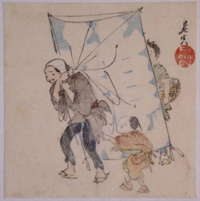
Click here to view image full size.
A rare surimono showing a family going kite flying. The man carrying a huge example on his back.
Very good impression and colour. Minor soil, otherwise good condition. Signed Zeshin with seal.
Status: Sold
Katsushika HOKUSAI (1760-1849)
Click here to view image full size.
Kaiba, Sea Horses, from a series of at least thirty surimono issued for the Yomo-gawa poetry group. Uma zukushi, “Horse Series” was commissioned for the Horse Year 1822 and each design alludes to the word horse. Here the dried sea horses are shown lying in a gold-lacquer folder beside a black-lacquer box containing a pair of beetles ( with connotations of potency ). This set, together with the “Shell Series” issued the previous year, is Hokusai’s most important set. A red hand-stamped title cartouche top right. Unidentified collector’s seal au verso. Rare.
Very fine impression and colour with gauffrage, silver, gold and bronze. Very slight discolouration to the yellow ground, otherwise very good condition. Signed Fusenkyo Iitsu hitsu.
Status: Sold
Ryuryukyo SHINSAI (1764 ?-1820)
Click here to view image full size.
A rare surimono showing a red bream, sea urchin, cuttle-fish, various other molluscs and two unidentified fish with seaweed. Issued c 1810s.
Fine impression with gauffrage. Fine colour and very good condition. Signed Shinsai.
Status: Sold




